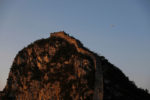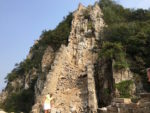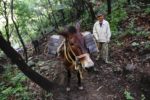 The Jiankou section of the Great Wall of China is famed for its picturesque tree-covered mountain locations and dramatic vistas of jagged peaks and plunging cliffs. Built about 50 miles north Beijing along the skinny spine of a mountain ridge with steep dropoffs left and right, Jiankou is a great draw to hikers and photographers fit enough to tackle the challenges of the winding rise and run of this section. They also have to be willing to take their lives in their hands, because it is a tough walk, all but vertical in some parts, and there are significant sections in dangerous disrepair.
The Jiankou section of the Great Wall of China is famed for its picturesque tree-covered mountain locations and dramatic vistas of jagged peaks and plunging cliffs. Built about 50 miles north Beijing along the skinny spine of a mountain ridge with steep dropoffs left and right, Jiankou is a great draw to hikers and photographers fit enough to tackle the challenges of the winding rise and run of this section. They also have to be willing to take their lives in their hands, because it is a tough walk, all but vertical in some parts, and there are significant sections in dangerous disrepair.
 The 12-miles stretch of wall at Jiankou was built during the Ming Dynasty (1369–1644). The Great Wall as we think of it today is largely the work of Ming emperors who took a scattershot collection of earthwork defenses built by their predecessors (the first border walls built to repel invaders go at least as far back as the 7th century B.C.) and transformed them into massive walls, first of tamped earth, then of stone and bricks. The Jiankou section was made of large white stone and bricks that contrast vividly with the dark greens of its wild backdrop.
The 12-miles stretch of wall at Jiankou was built during the Ming Dynasty (1369–1644). The Great Wall as we think of it today is largely the work of Ming emperors who took a scattershot collection of earthwork defenses built by their predecessors (the first border walls built to repel invaders go at least as far back as the 7th century B.C.) and transformed them into massive walls, first of tamped earth, then of stone and bricks. The Jiankou section was made of large white stone and bricks that contrast vividly with the dark greens of its wild backdrop.
 It’s not clear under which Ming emperor and when exactly the stone and brick Jiankou wall was constructed. Chinese chroniclers credit Ming general and scourge of Japanese pirates Qi Jiguang (1528–1588) with repairing and improving this section of the wall when he was put in charge of defending the northern frontier from the Mongols in 1572. He also added a great many watchtowers to strengthen the border defenses. The copious use of brick in Jiankou also suggests a 16th century date, but it’s likely that the overall work was done in multiple stages of restoration, improvement and maintenance.
It’s not clear under which Ming emperor and when exactly the stone and brick Jiankou wall was constructed. Chinese chroniclers credit Ming general and scourge of Japanese pirates Qi Jiguang (1528–1588) with repairing and improving this section of the wall when he was put in charge of defending the northern frontier from the Mongols in 1572. He also added a great many watchtowers to strengthen the border defenses. The copious use of brick in Jiankou also suggests a 16th century date, but it’s likely that the overall work was done in multiple stages of restoration, improvement and maintenance.
 Repairs to the Jiankou section stopped altogether Qing conquest of China in 1644. The Qing conquered the Mongol Empire and annexed it, so the old borders were no longer relevant. The difficult terrain compounded the neglect and the wall at Jiankou was left virtually untouched for almost 400 years. There’s a big upside to centuries of abandonment in a remote location: a lot of the original materials are still in place — damaged, collapsed, structurally unsound, but original and therefore restorable to something close to its 16th century condition. More accessible sections of the wall were used as quarries for local construction so much of the original masonry and brickwork is lost forever. Others have been repaired with historically inaccurate materials like concrete (which always ends in disaster; concrete is not the friend of historic preservation) to make them more tourist-friendly.
Repairs to the Jiankou section stopped altogether Qing conquest of China in 1644. The Qing conquered the Mongol Empire and annexed it, so the old borders were no longer relevant. The difficult terrain compounded the neglect and the wall at Jiankou was left virtually untouched for almost 400 years. There’s a big upside to centuries of abandonment in a remote location: a lot of the original materials are still in place — damaged, collapsed, structurally unsound, but original and therefore restorable to something close to its 16th century condition. More accessible sections of the wall were used as quarries for local construction so much of the original masonry and brickwork is lost forever. Others have been repaired with historically inaccurate materials like concrete (which always ends in disaster; concrete is not the friend of historic preservation) to make them more tourist-friendly.
 In 2005, a program of restoration began on the Jiankou section of the Great Wall. This is excruciatingly slow work because it’s so hard getting materials up the mountain — mule trains are often the only option, and even mules can get a little cranky having to haul more than 300 pounds of bricks apiece up a precipitous mountain ridge — and finding skilled workers to do the dangerous construction job. It takes a special kind of testicular fortitude to lay brick while dangling from a rope over a freaking abyss.
In 2005, a program of restoration began on the Jiankou section of the Great Wall. This is excruciatingly slow work because it’s so hard getting materials up the mountain — mule trains are often the only option, and even mules can get a little cranky having to haul more than 300 pounds of bricks apiece up a precipitous mountain ridge — and finding skilled workers to do the dangerous construction job. It takes a special kind of testicular fortitude to lay brick while dangling from a rope over a freaking abyss.
The restoration is now in its third phase and the focus is on preservation, not creating a new tourist trap. Original materials are used where possible, accurate reproduction using traditional crafts where not.
Where they could, workers used the original bricks that had broken off the wall over the centuries. Where there were none to be found, they used new bricks made to exacting specifications.
“We have to stick to the original format, the original material and the original craftsmanship, so that we can better preserve the historical and cultural values,” said Cheng Yongmao, the engineer leading Jiankou’s restoration.
Cheng, 61, who has repaired 17km of the Great Wall since 2003, belongs to the 16th generation in a long line of traditional brick makers.
[…]
Just a tenth of the wall built during the Ming Dynasty has been repaired, said Dong Yaohui, vice president of the China Great Wall Association.
“In the past, we would restore the walls so that they would be visited as tourist hot spots,” he said, by contrast with today’s objective of repairing and preserving them for future generations. “This is progress.”
Amen to that. This video shows some of the workers being badasses on an ordinary day at the job site.
Ah, the noble mule! Reliable, sure-footed, and smart. It inspires a God-like reverence in all that encounter it.
Don’t believe me? Look at that local fellow in the cap gazing in awe of the one in the pic. That’s the look of a mule man.
He he – Greatly observed, Bruce –of course, greatly described and, in particular, greatly being restored too :notworthy:
Just a question. I have not received any auto-emails from Word-Press (or whoever) from your site since you updated everything. Do you know how to fix that?
A great article! I have a new appreciation for the builders of the Wall.
If they’re going to mess with it, I guess this is the way to do it. I was lucky enough to visit the nearby Simatai section of the Great Wall in 2007, which, at that point, was similarly unrestored. I understand it’s now quite the tourist trap. I really enjoyed the unrestored nature of the section I visited, and I hope they see fit to leave some sections untouched.